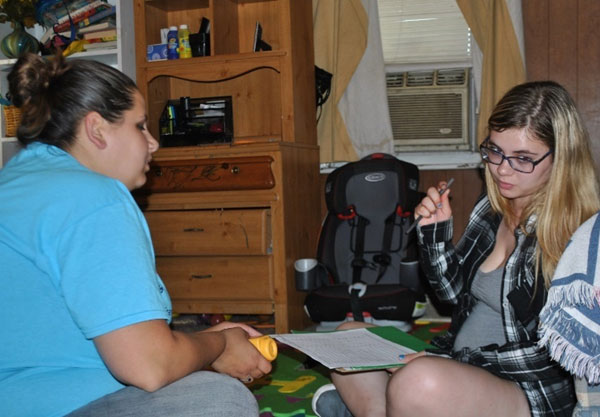Joint Planning
Open Doors
Chapter 6b: Joint Planning Experience It
Home Visitor: Let's think of something we can do next week. Since, today, we sort of looked more at what he's doing with sort of grasping and releasing. Is there something else that you want to work on around the border part? Or we can do something completely different, too.
Mom: I think, because he is pulling up and wanting to walk, I think it would be good to find something safe for him to work on his lower strength and just helping him pull himself up. So, I think that we should work on that next week.
Home Visitor: Okay, okay, so, we can do that, then. We can sort of see what toys you have. And then, things like this are great, because they're not going to move when he's pulling up. So, you can just practice, practice pulling up, all you want to, yeah.
Mom: Say "Bye-bye! Bye-bye!
Home Visitor: Bye, Mason. Bye, Mason.
Mom: Bye-bye.
Home Visitor: Good job! Look at you!
Mom: That's the first -- I'm sorry. That's the first time I've ever seen him do that.
Open Doors
Chapter 6b: Joint Planning Experience It
Home Visitor: Let's think of something we can do next week. Since, today, we sort of looked more at what he's doing with sort of grasping and releasing. Is there something else that you want to work on around the border part? Or we can do something completely different, too.
Mom: I think, because he is pulling up and wanting to walk, I think it would be good to find something safe for him to work on his lower strength and just helping him pull himself up. So, I think that we should work on that next week.
Home Visitor: Okay, okay, so, we can do that, then. We can sort of see what toys you have. And then, things like this are great, because they're not going to move when he's pulling up. So, you can just practice, practice pulling up, all you want to, yeah.
Mom: Say "Bye-bye! Bye-bye!
Home Visitor: Bye, Mason. Bye, Mason.
Mom: Bye-bye.
Home Visitor: Good job! Look at you!
Mom: That's the first -- I'm sorry. That's the first time I've ever seen him do that.
Reflections
What do you observe?
Answers may include:
- Home visitor briefly reviews what they did this week and asks the mother what she would like to do next week.
- Home visitor picks up a block and bangs it lightly in Mason's hand, talking to mother through the baby. Mother watches, smiles, and continues to say she would like to work on pulling up and lower body strength next week.
- Home visitor talks about finding things around the house that Mason can pull up on, pointing to a piece of furniture in the room that would be safe.
- Mother tells Mason to say "bye-bye," and he waves his fingers. She smiles and says that is the first time he has done that.
How can you apply what you observe from this brief interaction about joint planning to your home visits?
Answers may include:
- Joint planning doesn't have to be a long, involved process. It can simply be a few questions about what the child is doing or on what the parent would like to work. Then, the two of you can brainstorm what you might find in the home to support this development.
- Parents should be involved in the planning of home visits so they will have an investment in carrying out the home visit.
- If the parent is involved in gathering materials for the home visit, they will be more likely to take interest in engaging the child with the materials.
- Home visitor should be prepared with some questions that might engage the parent in jointly planning the next home visit.


 One of the major purposes of the home-based option is to help parents explore and experience where their child is developmentally, what interests the child, how the child learns in each domain, and how to support that learning through everyday routines and experiences. You can help parents understand early learning and development and what they can do to keep their child healthy and safe from injury. This affirms their role in promoting school readiness and positive health outcomes.
One of the major purposes of the home-based option is to help parents explore and experience where their child is developmentally, what interests the child, how the child learns in each domain, and how to support that learning through everyday routines and experiences. You can help parents understand early learning and development and what they can do to keep their child healthy and safe from injury. This affirms their role in promoting school readiness and positive health outcomes.